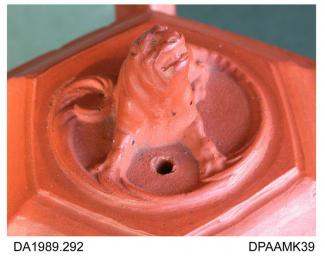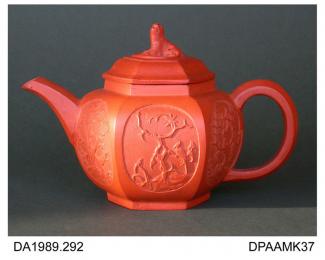Teapot, red stoneware, curved hexagonal shape with exotic birds and trees relief-moulded in panels, lid with Chinese lion knop, not marked, made by John and David Elers, Bradwell Hall, near Newcastle-under-Lyme, Staffordshire, c1690-98
Around 1690 John Elers made a fine red unglazed stoneware, in the Chinese manner, at Bradwell Wood in Staffordshire. Production ceased around 1700, and red stonewares would not be produced again, in Staffordshire, until about 1750. The Elers brothers used a knowledge of casting in metal in order to form wares from liquid clay in moulds; the shape and decoration are both derived from contemporary teapots imported from China, though with added flourishes such as the long encircling extension to the lion's tail.
This is one of the earliest types of English teapot, small, expensive and intended for a wealthy consumer of the newly fashionable tea. In the absence of Chinese porcelain prototypes, this was inspired by red stoneware pots imported from Yixing.
Materials & Making
Red stoneware, favoured by the Chinese for making teapots that could safely be heated over a brazier, were imported into Europe shortly after the mid-17th century. Dutch potters immediately made copies, followed by the experiments of John Dwight at Fulham and his patent of 1684, and the arrival in London from Holland shortly after of the Elers brothers. They worked as Dwight's assistants in 1690-1693, then moved to Staffordshire, where they identified veins of suitable red clay at Bradwell Wood. The material was expensive, and there was no glaze to hide any blemishes formed in the course of manuftacture. The extremely high standard of craftsmanship displayed in the Elers's pots, as well as their subsequent bankruptcy in 1700, are attributable to their exclusive use of the silversmithing techniques they had learned years before in Holland: slip-casting and lathe-turning.
People
John Phillip Elers and David Elers, though claimed now as pioneer potters in Britain, always remained aloof from other potters, obsessively hiding their processes from possible rivals. Thus when red stoneware teawares were again manufactured in Staffordshire from around 1750, it was an independent rediscovery by local potters.
Around 1690 John Elers made a fine red unglazed stoneware, in the Chinese manner, at Bradwell Wood in Staffordshire. Production ceased around 1700, and red stonewares would not be produced again, in Staffordshire, until about 1750. The Elers brothers used a knowledge of casting in metal in order to form wares from liquid clay in moulds; the shape and decoration are both derived from contemporary teapots imported from China, though with added flourishes such as the long encircling extension to the lion's tail.
This is one of the earliest types of English teapot, small, expensive and intended for a wealthy consumer of the newly fashionable tea. In the absence of Chinese porcelain prototypes, this was inspired by red stoneware pots imported from Yixing.
Materials & Making
Red stoneware, favoured by the Chinese for making teapots that could safely be heated over a brazier, were imported into Europe shortly after the mid-17th century. Dutch potters immediately made copies, followed by the experiments of John Dwight at Fulham and his patent of 1684, and the arrival in London from Holland shortly after of the Elers brothers. They worked as Dwight's assistants in 1690-1693, then moved to Staffordshire, where they identified veins of suitable red clay at Bradwell Wood. The material was expensive, and there was no glaze to hide any blemishes formed in the course of manuftacture. The extremely high standard of craftsmanship displayed in the Elers's pots, as well as their subsequent bankruptcy in 1700, are attributable to their exclusive use of the silversmithing techniques they had learned years before in Holland: slip-casting and lathe-turning.
People
John Phillip Elers and David Elers, though claimed now as pioneer potters in Britain, always remained aloof from other potters, obsessively hiding their processes from possible rivals. Thus when red stoneware teawares were again manufactured in Staffordshire from around 1750, it was an independent rediscovery by local potters.






